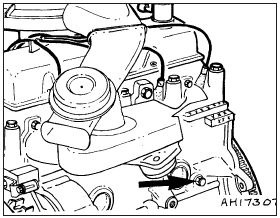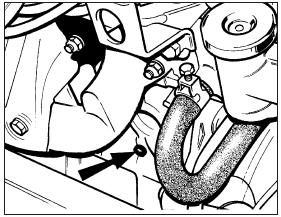Coolant renewal (Every 24 000 miles or 2 Years)
Cooling system draining 1 It is preferable to drain the system when the coolant is cold. If it must be drained when hot, release the pressure cap on the thermostat housing (or expansion tank on later models) very slowly, having first covered it with a cloth to avoid any possibility of scalding. Having relieved the pressure, remove the cap.
2 Set the heater control to the maximum heat position.
3 Check to see if a drain plug is fitted to the lower left-hand side of the radiator. If so, place a suitable container beneath the radiator, unscrew the plug and allow the coolant to drain (see illustration).

33.3 Radiator drain plug location (arrowed)
4 If a drain plug is not fitted, place the container beneath the radiator bottom hose.
Slacken the clip, release the hose and allow the coolant to drain.
5 A cylinder block drain plug is also fitted to certain models on the forward facing side of the cylinder block, towards the flywheel end.
Where this is the case, unscrew the plug and allow the cylinder block to drain into the container (see illustrations).

33.5a Cylinder block drain plug location (arrowed) - OHV engines

33.5b Cylinder block drain plug location (arrowed) - CVH engines
Cooling system flushing 6 Providing that the correct mixture of antifreeze and water has previously been maintained in the system, then no flushing should be necessary and the system can be refilled immediately as described in the following paragraphs.
7 Where the system has been neglected however, and rust or sludge is evident at draining, then the system should be flushed through using a cold water hose inserted into the thermostat housing (thermostat removed - see Chapter 3). Continue flushing until the water flows clean from the disconnected bottom hose, radiator drain plug and cylinder block drain plug, as applicable. If, after a reasonable period the water still does not run clear, the radiator can be flushed with a good proprietary cleaning system.
8 If the radiator is suspected of being clogged, remove and reverse flush it as described in Chapter 3.
9 When the coolant is being changed, it is recommended that the overflow pipe is disconnected from the expansion tank and the coolant drained from the tank. If the interior of the tank is dirty, remove it and thoroughly clean it out.
10 After draining or flushing, reconnect all disconnected hoses and refit the drain plugs where applicable.
Cooling system filling
11 Using the correct antifreeze mixture (See
following sub-Section) fill the system through
the thermostat housing filler neck slowly until
the coolant is nearly overflowing. Wait a few
moments for trapped air to escape and add
more coolant. Repeat until the level does not
drop and refit the cap. Pour similar strength
coolant into the expansion tank up to the
“MAX” mark and fit the cap.
12 On later models with a screw type pressure cap on the expansion tank, fill the system in the same way, but through the expansion tank rather than the thermostat housing.
13 On all models start the engine and run it to normal operating temperature then switch off.
Once it has cooled, check and carry out any final topping-up to the expansion tank only.
Antifreeze mixture
14 Never operate the vehicle with plain water
in the cooling system. Apart from the danger
of freezing during winter conditions, an
important secondary purpose of antifreeze is
to inhibit the formation of rust and to reduce
corrosion.
15 The coolant must be renewed at the intervals specified. Although the antifreeze properties of the coolant will remain indefinitely, the effectiveness of the rust and corrosion inhibitors will gradually weaken.
16 It is recommended that Ford Super Plus antifreeze is used for filling and topping-up, as it has been specially formulated for use in Ford mixed metal engines (see “Lubricants and fluids”).
17 A solution of 45% antifreeze must be maintained in the system all year round which will provide adequate protection against frost, rust and corrosion.
18 After filling with antifreeze, a label should be attached to the radiator stating the type of antifreeze and the date installed. Any subsequent topping-up should be made with the same type and concentration of antifreeze.
19 Do not use engine antifreeze in the screen washer system, as it will cause damage to the vehicle paintwork. Screen wash antifreeze is available from most motor accessory shops.
See also:
Rear anti-roll bar (Saloon, Hatchback and Estate models) - removal and
refitting
Removal
1 Loosen the rear roadwheel nuts, chock the
front wheels, jack up the rear of the vehicle
and support on axle stands placed under the
side members.
2 Prise off the straps which connect th ...
Engine dismantling, examination, renovation and reassembly - general
information
Dismantling
1 It is best to mount the engine on a
dismantling stand but if this is not available,
stand the engine on a strong bench at a
comfortable working height. Failing this, it will
have to ...
Engine/transmission - removal and separation
Note: Suitable lifting tackle will be required for
this operation.
Carburettor engines
Removal
1 The engine is removed complete with the
transmission in a downward direction and then
withdrawn f ...
